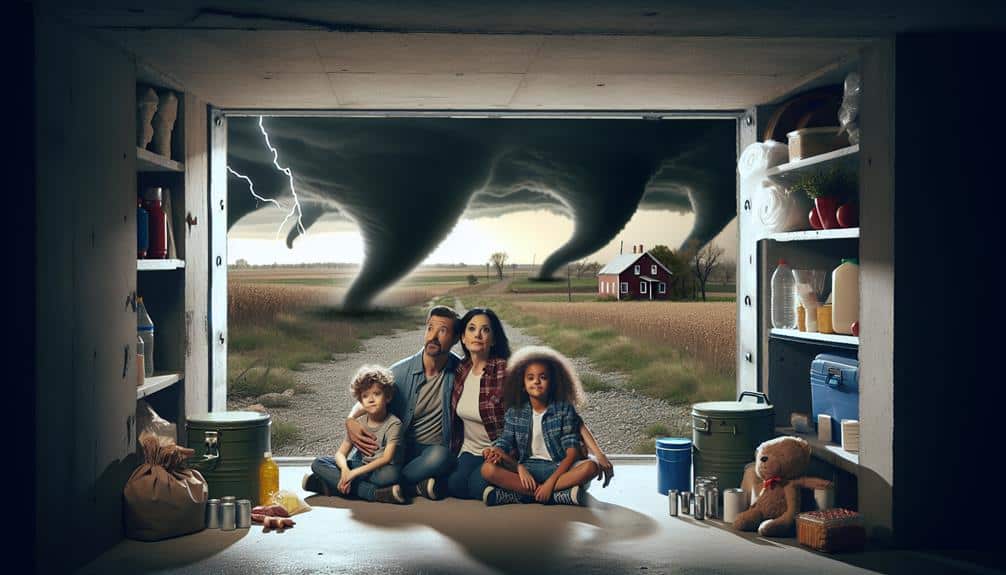Hidden storm shelters are crucial in rural areas because they greatly improve community safety and emergency preparedness. We can easily access these shelters during severe weather, reducing response times and guaranteeing protection against tornadoes and floods. By strategically positioning shelters, we've optimized their accessibility, strengthening the community's ability to bounce back and allowing faster emergency responses. They also demonstrate cost-effectiveness, reducing insurance expenses and boosting property values. Innovative designs using eco-friendly materials further secure our safety and environmental awareness. To understand how these shelters fully support rural safety and infrastructure, let's delve into how they're put into practice and upheld.
Key Points
- Hidden storm shelters provide reliable refuge for rural communities during severe weather conditions.
- Strategic placement ensures rapid access and enhances emergency response capabilities in remote areas.
- Advanced construction techniques make shelters durable and able to withstand extreme weather.
- Community engagement in shelter planning fosters ownership and improves overall emergency preparedness.
Improved Safety Measures
We've significantly enhanced safety measures in rural storm shelters to guarantee enhanced protection during severe weather events. Our focus on emergency preparedness and community support has transformed how these shelters function. By integrating advanced materials and construction techniques, we've made sure that rural storm shelters can withstand extreme conditions. This makes them a reliable refuge for communities facing tornadoes, hurricanes, and other severe weather.
Shelter accessibility has been a significant factor in our efforts. Recognizing that rural infrastructure often lacks the extensive resources found in urban areas, we've prioritized making these shelters easy to reach and use. Enhanced entry points and clearly marked locations ensure that everyone, regardless of mobility, can quickly find safety.
Community support plays a pivotal role in these improvements. Training programs and public awareness campaigns educate residents on the importance of storm preparedness and the specific safety features of local shelters. This collective effort enhances overall resilience and fosters a sense of unity and self-reliance in rural areas.
In essence, by focusing on robust emergency preparedness, improving shelter accessibility, and leveraging community support, we've created a safer, more resilient environment for those living in rural regions.
Access During Emergencies
Ensuring rapid access to storm shelters during emergencies is essential to safeguarding rural communities. When severe weather strikes, every second counts, and having a well-thought-out emergency preparedness plan can make all the difference.
In rural areas, where homes and farms are often spread out across remote locations, shelter accessibility becomes even more crucial. We need to ensure that everyone knows the quickest routes to their nearest hidden storm shelter.
Emergency preparedness in rural communities isn't just about having shelters; it's about making sure they're accessible. It's vital to clear paths and maintain roads leading to these shelters, especially given the rugged terrain typical of remote locations. Residents should also be familiar with the shelter's layout—knowing where to find first-aid kits and emergency supplies.
Furthermore, communication can be a significant challenge in these areas. Reliable systems for alerting residents to impending danger and guiding them to safety are essential. We can't afford delays caused by lack of information or unclear instructions.
Protection From Severe Weather
We need effective measures to protect ourselves from severe weather in rural areas.
Tornado safety plans, flood defense strategies, and wind damage prevention are vital components.
Tornado Safety Measures
During tornado season, taking proactive measures can greatly enhance our safety and protection from severe weather. One critical step in emergency preparedness is making sure we've accessible storm shelters.
In rural areas, where help might be far away, having a well-thought-out plan can mean the difference between life and death. First, let's discuss emergency preparedness. We must stay informed about weather conditions and have a plan in place. This includes knowing the safest routes to our shelters and keeping emergency kits stocked with essentials like water, non-perishable food, and first-aid supplies. It's not just about having a shelter; it's about our readiness to use it effectively.
Shelter accessibility is equally important. Tornadoes don't wait, and neither should we. Our shelters need to be easy to reach, even in the chaos of an imminent tornado. This means they should be situated in a convenient location, free from obstructions, and known to everyone in the household. Practicing drills can make certain everyone knows exactly where to go and what to do when the sirens sound.
Flood Defense Strategies
While tornadoes pose a significant threat, we must also prepare for another severe weather event common in rural areas: flooding. Flood preparedness is essential to protect our communities and ensure our safety. Hidden storm shelters can be a lifesaver during floods, providing a secure place to stay until the waters recede.
We need to establish effective flood defense strategies, including:
- Evacuation routes: Mapping out clear and accessible evacuation routes is crucial. Knowing where to go and how to get there quickly can save lives.
- Community drills: Regular community drills help everyone to stay prepared. Practicing evacuation routes and shelter procedures ensures we're ready when disaster strikes.
Floods can be unpredictable, and having a detailed plan in place makes a significant difference. By focusing on these strategies, we empower ourselves to face severe weather with confidence.
Let's take these steps seriously to protect our families and maintain our freedom in the face of natural disasters.
Wind Damage Prevention
Protecting our homes and communities from wind damage requires strategic planning and robust construction practices. In rural areas, where infrastructure can be less developed, emphasis on structural reinforcement becomes vital. By integrating weather resistant construction methods, we can fortify our buildings to withstand severe weather conditions. This isn't just about adding a few extra nails; it's about using materials and designs that provide long-term durability against high winds.
Emergency preparedness is also important. We need to have well-thought-out plans in place for when storms hit. Hidden storm shelters play a pivotal role in this. They offer us a safe refuge, significantly reducing the risk of injury and fatalities. These shelters should be constructed with the same attention to weather resistant principles, ensuring they remain secure during extreme conditions.
In enhancing rural infrastructure, we're not only protecting property but also empowering our communities. By focusing on structural reinforcement and emergency preparedness, we equip ourselves with the freedom to live without constant fear of the next storm. Investing in these areas isn't just prudent; it's a necessity for safeguarding our way of life.
Strategic Placement Benefits
Strategically situating storm shelters in rural areas can greatly enhance community safety and emergency response times. By focusing on rural readiness, we guarantee that residents are better prepared for severe weather events, reducing potential casualties and property damage. Proper shelter positioning is vital in maximizing accessibility and minimizing response times.
When we think about strategic placement, several benefits come to mind:
- Accessibility: Placing shelters in easily reachable locations guarantees that community members can reach safety quickly, even during sudden storms.
- Resource Optimization: Strategic positioning allows us to optimize resources, guaranteeing that the maximum number of people can be protected with the least amount of infrastructure.
Enhancing Community Resilience

Maximizing the strategic positioning of storm shelters not only enhances immediate safety but also strengthens the overall resilience of rural communities. When we place these shelters thoughtfully, we enable quick access during emergencies, greatly boosting our emergency response capabilities. This strategic approach ensures that everyone, regardless of location, has a secure place to go when severe weather strikes.
Community engagement plays a vital role in this process. By involving local residents in the planning and implementation stages, we foster a sense of ownership and responsibility. This collective effort not only enhances the effectiveness of the shelters but also builds a network of informed and prepared individuals. When community members are actively engaged, they're more likely to participate in emergency drills and stay updated on safety protocols.
Furthermore, having well-positioned storm shelters allows us to respond more effectively during disasters. A well-coordinated emergency response system, supported by accessible shelters, means we can reduce casualties and property damage. These shelters become pivotal points for distributing aid and coordinating rescue efforts, making our communities more resilient in the face of natural disasters.
Essentially, hidden storm shelters are more than just safe havens; they're linchpins in building stronger, more resilient rural communities.
Cost-Effectiveness and Value
Investing in storm shelters offers significant cost-effectiveness by mitigating potential losses from severe weather events. For those of us living in rural communities, the economic benefits and long-term value of such investments can't be overstated. When we weigh the financial impact of property damage, loss of livestock, and potential personal injury, the upfront cost of a storm shelter becomes a bargain.
Hidden storm shelters contribute to our preparedness strategies, ensuring we're ready when disaster strikes. Here are some key points to take into account:
- Reduced Insurance Premiums: Many insurance companies offer lower premiums for properties equipped with storm shelters, translating to substantial savings over time.
- Property Value Increase: Homes with storm shelters often see a boost in property value, making them more attractive to potential buyers.
These shelters provide us with a cost-effective way to safeguard our lives and assets, delivering long-term value that far exceeds the initial expense.
In a world where preparedness is paramount, hidden storm shelters are a wise and necessary investment.
Innovations in Shelter Design

In recent years, we've seen significant advancements in shelter design, particularly in creating compact and efficient layouts that maximize space and functionality.
Additionally, the use of advanced materials has enhanced durability and safety while keeping costs manageable.
These innovations not only make shelters more effective but also guarantee they're accessible to more rural communities.
Compact and Efficient Layouts
While addressing the need for space efficiency, modern storm shelter designs incorporate compact layouts without compromising safety or functionality. We grasp that in rural areas, space can be both limited and precious. That's why designers are pushing the boundaries of space optimization and functionality enhancement to create shelters that are both effective and unobtrusive.
By adopting innovative layouts, these shelters maximize every square inch, ensuring that even the smallest spaces can offer robust protection. Key features of these compact designs include:
- Multi-functional surfaces: Walls and benches that double as storage units.
- Collapsible furniture: Foldable seating and tables to free up space when not in use.
These elements guarantee that our shelters aren't only practical but also comfortable during emergencies. The focus on space optimization allows us to install these shelters in various environments, from beneath porches to within garage floors, without disrupting the existing landscape.
Ultimately, the goal is to provide rural communities with storm shelters that offer both peace of mind and the freedom to maintain their way of life. Compact and efficient layouts make this possible, proving that good design can solve critical problems without sacrificing comfort or utility.
Advanced Material Usage
Building on our dedication to space efficiency, we now shift our focus to the advanced materials that are transforming storm shelter design. In rural areas, where sustainability and cost-effectiveness are crucial, the use of eco-friendly materials isn't just a preference but a necessity. By integrating sustainable construction techniques, we can create shelters that are both resilient and environmentally conscious.
One of the most significant advancements is the use of reinforced concrete with recycled content. This material offers exceptional durability and strength while minimizing environmental impact. Additionally, high-performance insulation made from recycled fibers ensures that our shelters maintain a stable internal climate, reducing the need for additional energy consumption.
We're also exploring the use of composite materials that incorporate natural fibers like hemp and bamboo. These materials aren't only sustainable but also offer superior flexibility and resistance to harsh weather conditions.
Frequently Asked Questions
How Do Hidden Storm Shelters Impact Property Insurance Rates in Rural Areas?
Hidden storm shelters often lead to insurance discounts, resulting in cost savings for homeowners. By reducing potential storm damage, we lower risk profiles, which insurance companies reward with lower premiums, offering a measure of financial freedom.
Are There Any Government Grants Available for Building Hidden Storm Shelters?
Yes, there are government grants for hidden storm shelters. Funding options often depend on eligibility criteria. Community partnerships can provide additional resources, making it easier for us to build and maintain these essential shelters.
What Are the Maintenance Requirements for Hidden Storm Shelters?
Maintaining hidden storm shelters is like tending a secret garden. We need regular inspections, cleaning, and proper ventilation to guarantee safety. Don't forget repairs, emergency supplies, and clear escape routes to keep our sanctuary ready.
Can Hidden Storm Shelters Be Customized for Multi-Purpose Use?
We can definitely customize hidden storm shelters for multi-purpose use. They can serve as emergency storage during storms or act as a secret hideaway, providing both safety and functionality, perfectly aligning with our desire for freedom and preparedness.
How Do Hidden Storm Shelters Affect Property Resale Value?
We might think hidden storm shelters don't add value, but they actually boost resale value in rural markets. Prospective buyers often prioritize safety and preparedness, thereby enhancing property value and marketability regardless of location.


